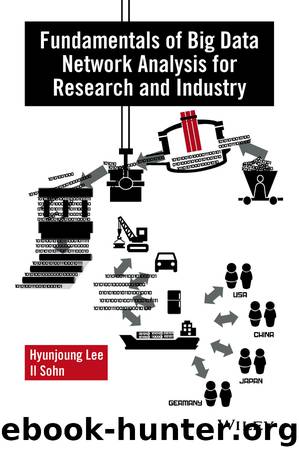Fundamentals of Big Data Network Analysis for Research and Industry by Hyunjoung Lee & Il Sohn

Author:Hyunjoung Lee & Il Sohn [Lee, Hyunjoung & Sohn, Il]
Language: eng
Format: epub
ISBN: 9781119015499
Publisher: Wiley
Published: 2015-12-30T00:00:00+00:00
5.1.1.1 Nondirectional Relationship
The number of an actor’s connections with other actors is an important measurement index. Therefore, the individual centrality of an actor can represent the node’s connectivity, d(ni), and degree centrality is the total sum of the connection between the nodes. A standardized centrality can be obtained through Equation 5.1 and can be used to compare the size of the network with other networks with different sizes. CD(ni) is the degree centrality of the node i and g is the total number of nodes.
(5.1)
For an actor, a high degree centrality indicates the actor’s high level of activity within the network. The degree of centrality is focused on identifying the high-profile actor within the network analysis. When an actor is has a vast number of connections to other actors, that actor will be at the center of the network and other actors will expect him or her to lead in disseminating information within the network using his or her numerous network relationships. Conversely, actors with a low degree of centrality who are located far from the core of the network may be considered as unimportant, low-activity actors. If an actor has absolutely no relationship with other actors, that actor can be excluded from the network and have no end effect on the analysis of the relationships within the network.
If the trade relationship matrix of iron and steel is transformed to a matrix without direction and weight, Table 5.2 will result, with cells having a value of 1 for existing trade amounts; the empty cells will coincide with nonexisting trade amounts. Table 5.3 contains the degree of centrality of the individual nodes from Table 5.2 and shows the United States to have the highest degree of centrality. This implies that the United States has more trading countries within the network than any other country (Figure 5.2).
Table 5.2 Non-directional trade relationship matrix.
Download
This site does not store any files on its server. We only index and link to content provided by other sites. Please contact the content providers to delete copyright contents if any and email us, we'll remove relevant links or contents immediately.
| Access | Data Mining |
| Data Modeling & Design | Data Processing |
| Data Warehousing | MySQL |
| Oracle | Other Databases |
| Relational Databases | SQL |
Algorithms of the Intelligent Web by Haralambos Marmanis;Dmitry Babenko(7881)
Learning SQL by Alan Beaulieu(5450)
Weapons of Math Destruction by Cathy O'Neil(5075)
Big Data Analysis with Python by Ivan Marin(3191)
Blockchain Basics by Daniel Drescher(2910)
Building Statistical Models in Python by Huy Hoang Nguyen & Paul N Adams & Stuart J Miller(2829)
Azure Data and AI Architect Handbook by Olivier Mertens & Breght Van Baelen(2798)
Serverless Machine Learning with Amazon Redshift ML by Debu Panda & Phil Bates & Bhanu Pittampally & Sumeet Joshi(2721)
Hands-On Machine Learning for Algorithmic Trading by Stefan Jansen(2572)
Pandas Cookbook by Theodore Petrou(2519)
Mastering Python for Finance by Unknown(2505)
Data Wrangling on AWS by Navnit Shukla | Sankar M | Sam Palani(2505)
Driving Data Quality with Data Contracts by Andrew Jones(2385)
Data Engineering with dbt by Roberto Zagni(2262)
How The Mind Works by Steven Pinker(2241)
Machine Learning Model Serving Patterns and Best Practices by Md Johirul Islam(2177)
Building Machine Learning Systems with Python by Richert Willi Coelho Luis Pedro(2066)
Network Science with Python and NetworkX Quick Start Guide by Edward L. Platt(2047)
Learn T-SQL Querying by Pam Lahoud & Pedro Lopes(1978)
